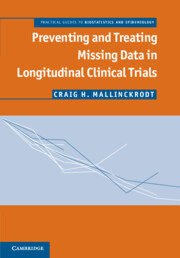Book contents
4 - Trial Design Considerations
Published online by Cambridge University Press: 05 February 2013
Summary
Introduction
One of the key recommendations from the NRC guidance on prevention and treatment of missing data (NRC, 2010) is that investigators, sponsors, and regulators should design clinical trials consistent with the goal of maximizing the number of participants maintained on the protocol-specified interventions until the outcome data are collected.
However, minimizing missing data is easier said than done. The usefulness of data from actual clinical trials in assessing how design features influence retention is limited because studies are not done with this objective in mind. Therefore, most assessments are on a between-study basis, and thus many confounding factors can mask or exaggerate differences attributable to trial methods. Mindful of these limitations, the NRC Guidance provides a number of suggestions on ways to minimize missing data via trial design, which are discussed in this chapter.
Design Options to Reduce Missing Data
Run-in Periods and Enrichment Designs
Treatments typically do not work equally well in all patients. If there is a systematic trend for some groups of patients to have better outcomes, this knowledge can be used to reduce dropout by testing the treatment in the subpopulation with the greatest drug benefit. Pretesting and/or selecting patients with greater potential drug benefit prior to randomization is termed enrichment (NRC, 2010).
Information
- Type
- Chapter
- Information
- Preventing and Treating Missing Data in Longitudinal Clinical TrialsA Practical Guide, pp. 23 - 32Publisher: Cambridge University PressPrint publication year: 2013
